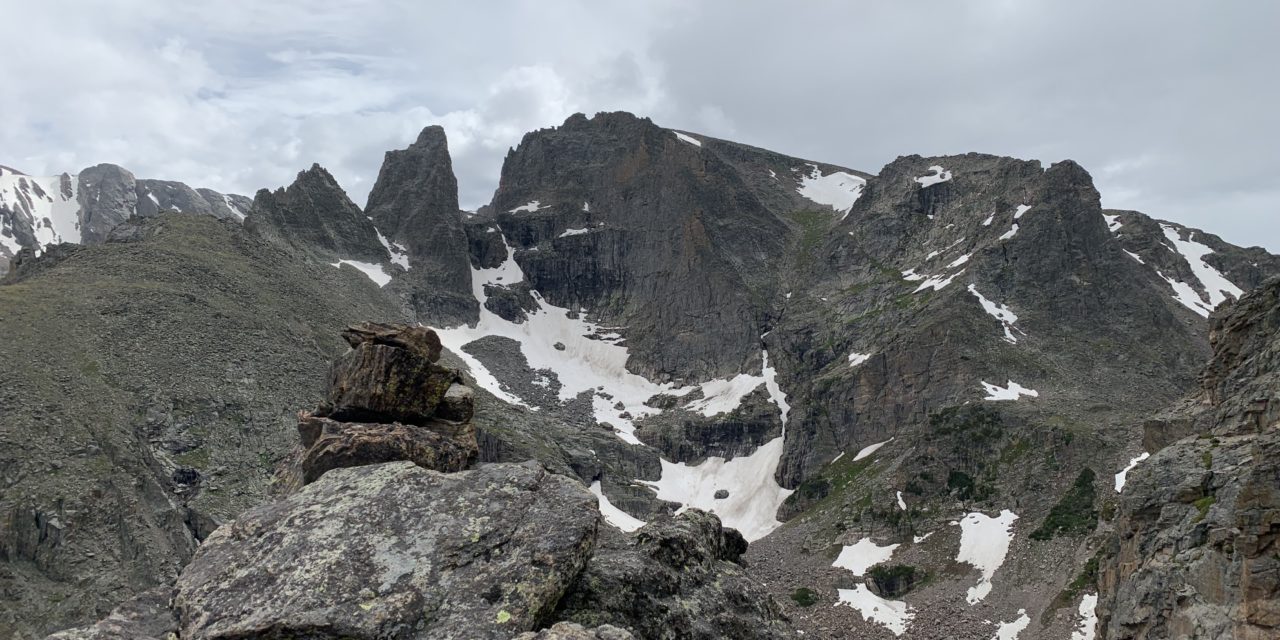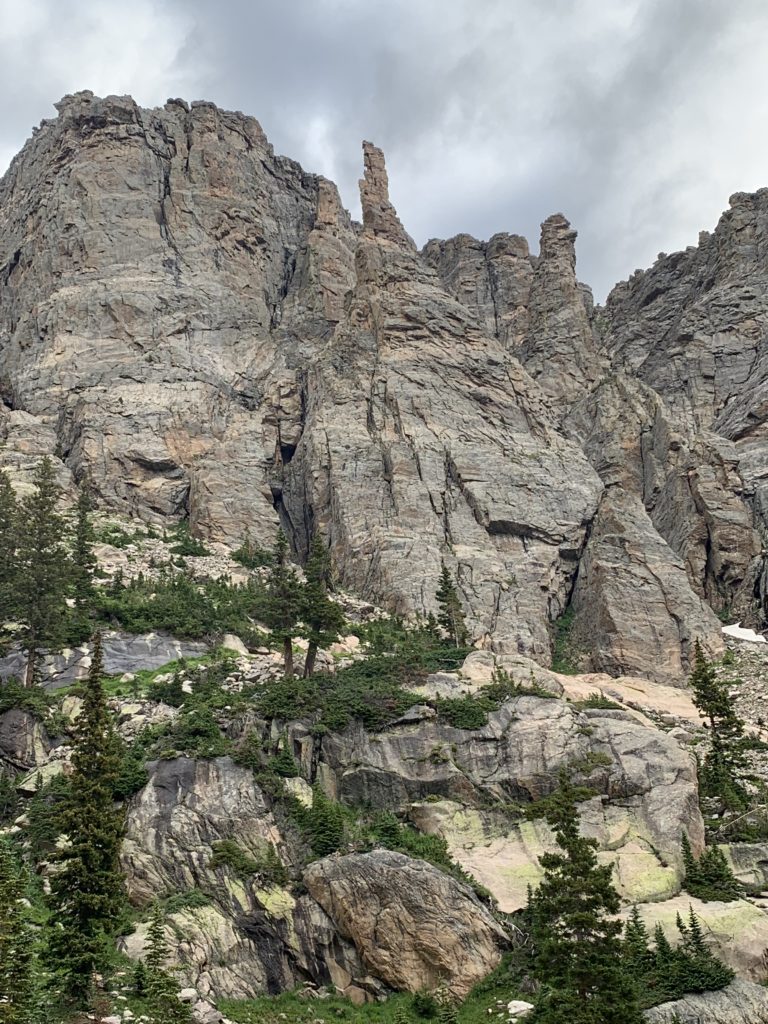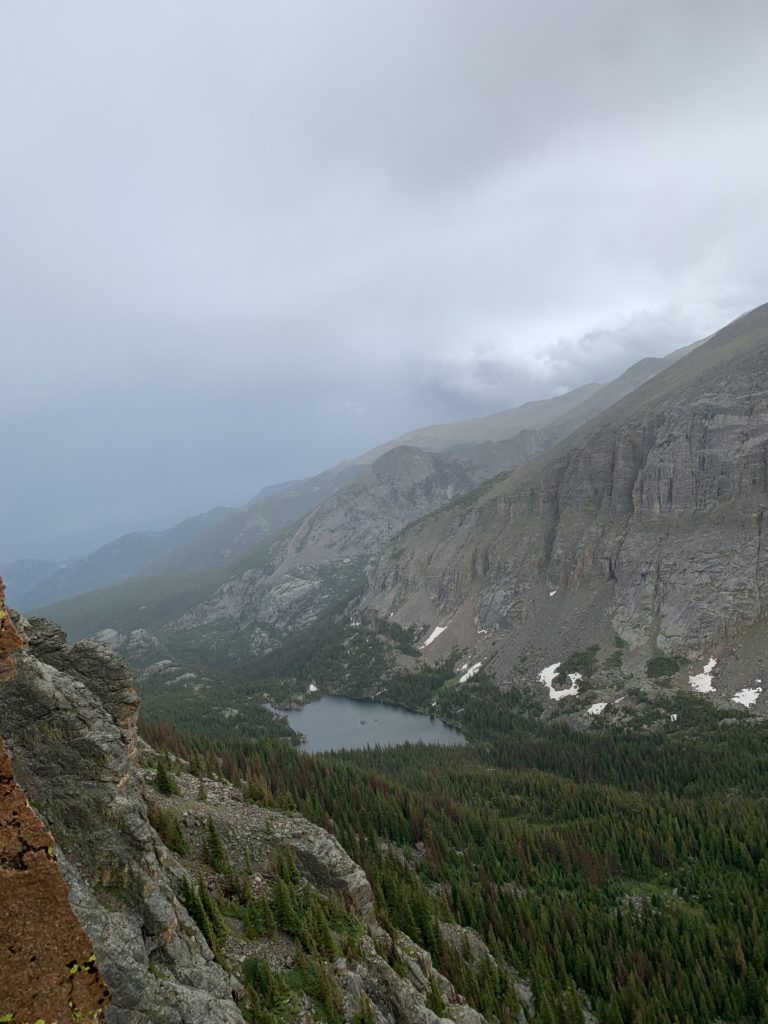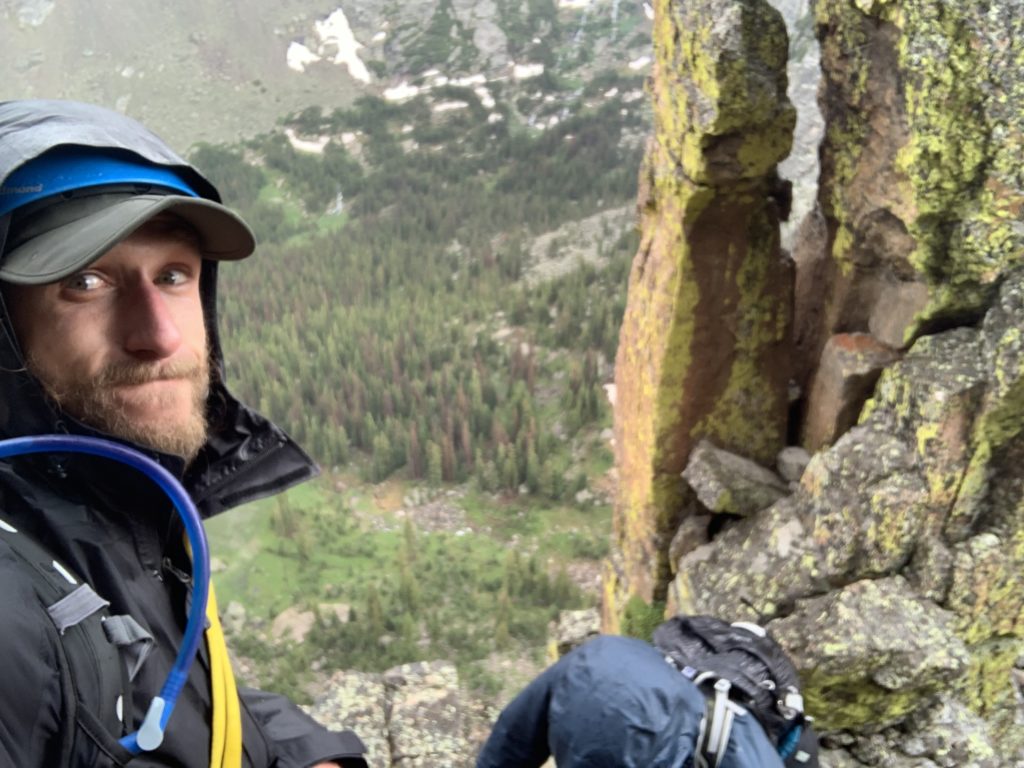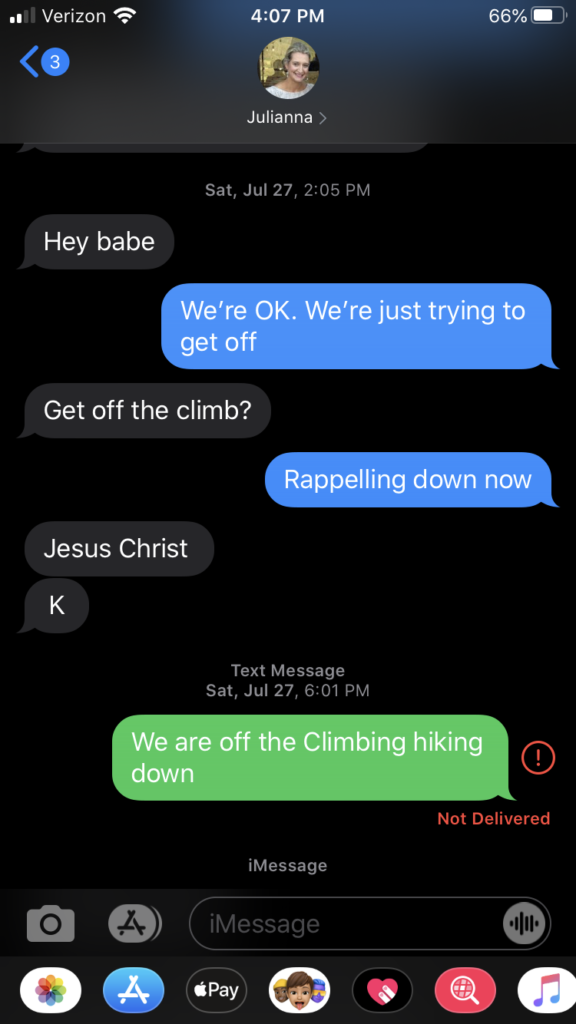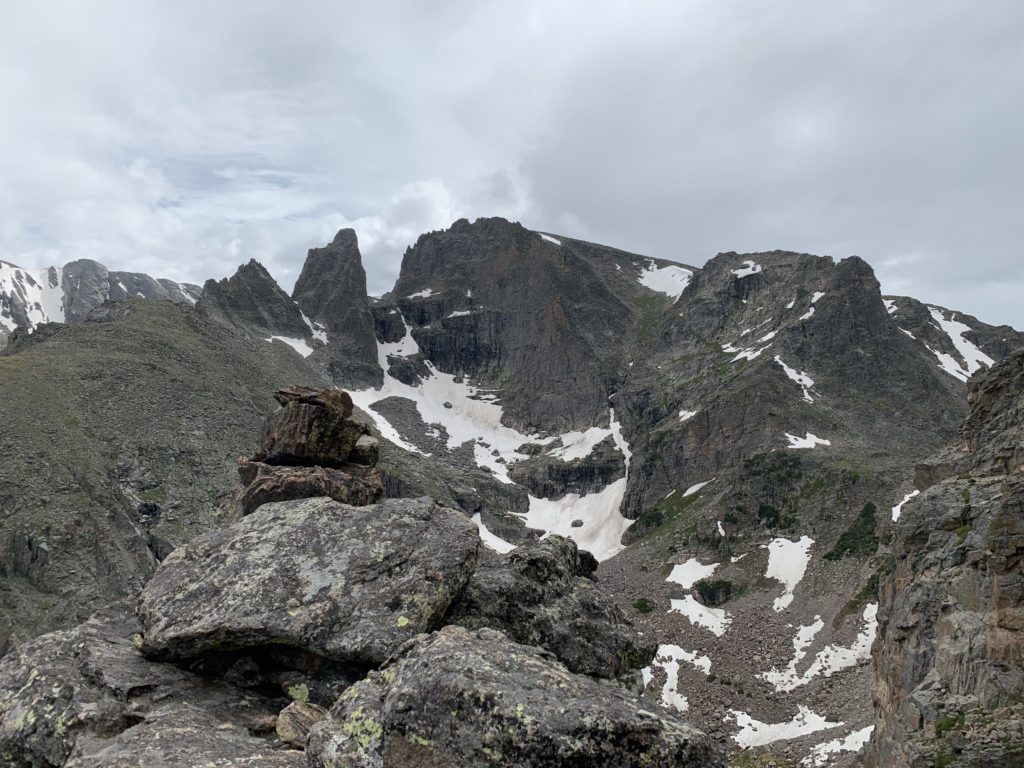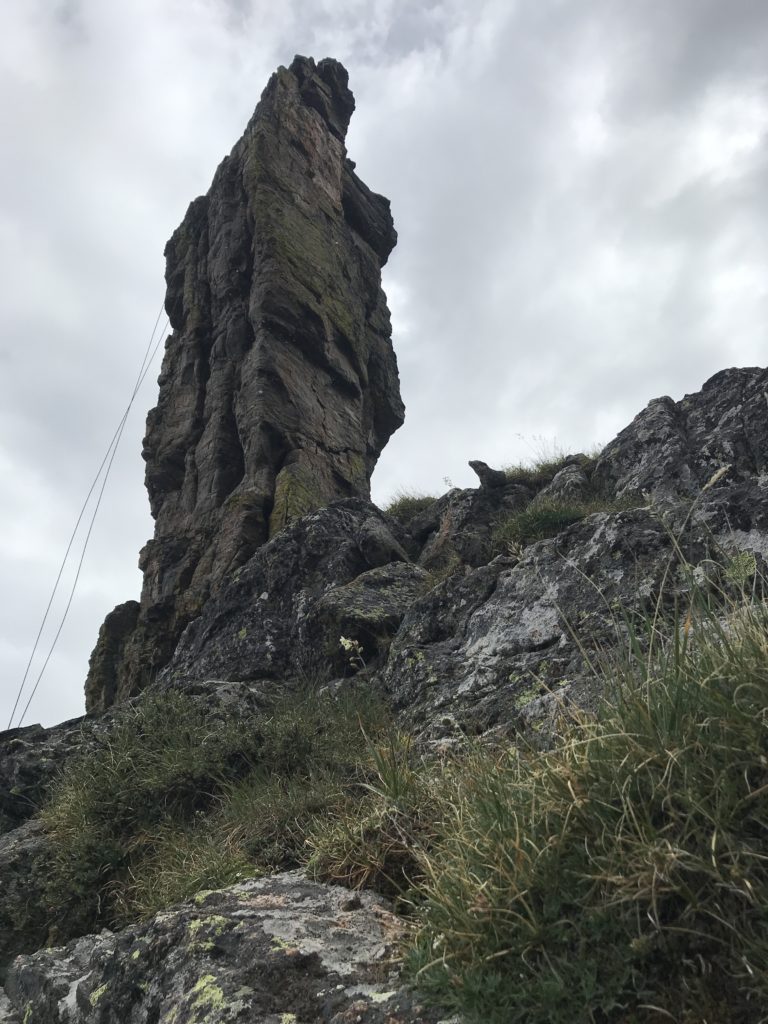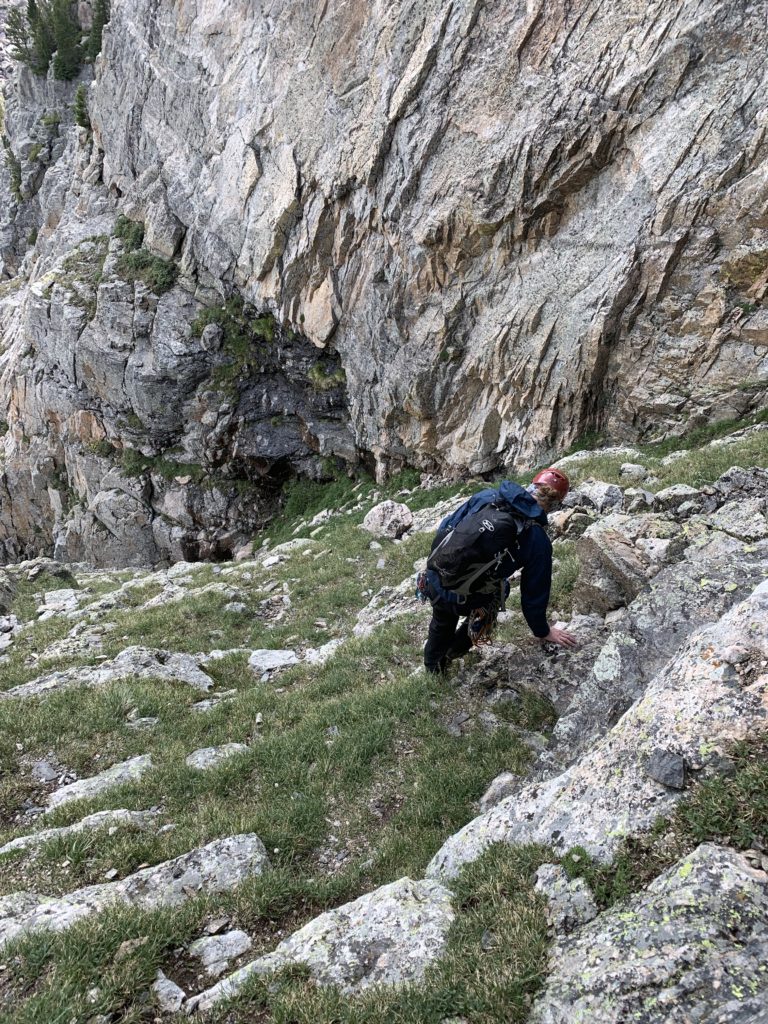The day started out routine enough. A pre-dawn wake-up call and an easy drive to the Glacier Gorge trailhead went smoothly. The four-mile hike seemed to fly by, our legs buoyed by the adventure ahead of us. We had scarcely set our packs down when a crack and a scream tore through the air. Soon, pebbles and rocks were raining down around my partner Eli and I, with thundering booms echoing off the walls and boulders careening down the scree field. We dove against the wall, and laughed a little, mostly out of fear and confusion.
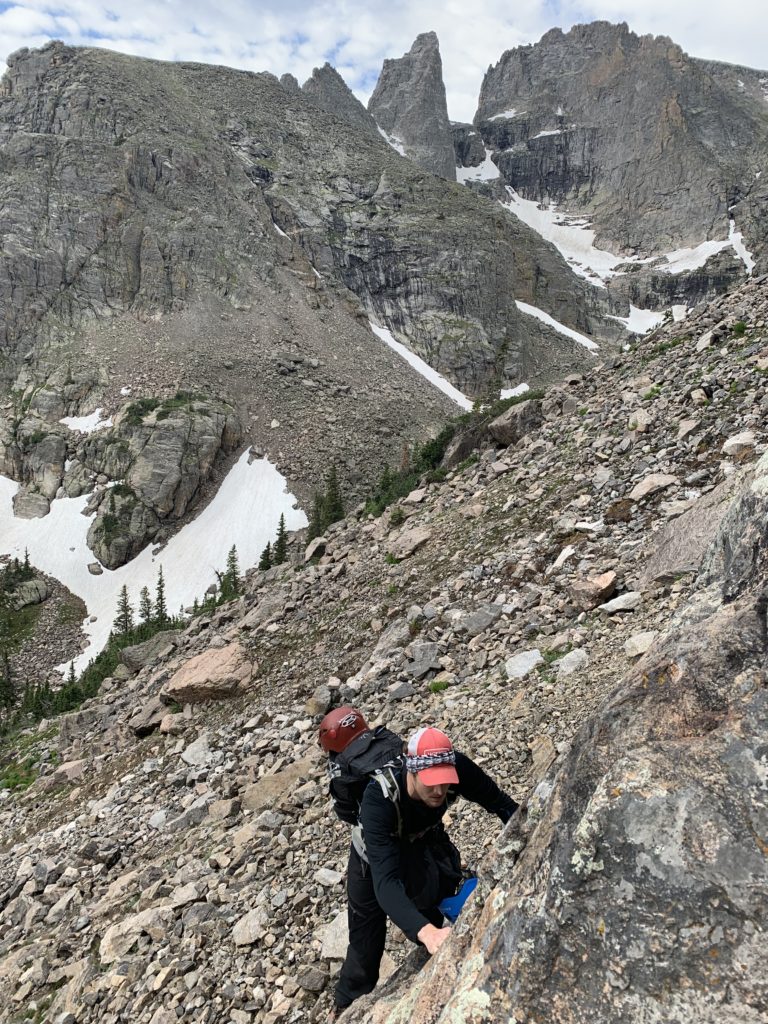
The author scrambling to the base of the wall, seconds before the rocks started raining down. The classic RMNP peak Sharkstooth is in the background.
We were standing at the base of Otis Peak in Rocky Mountain National Park, intending to climb the South Face, a moderate, long alpine trad route. The beta we had collected said this route was grade III, 5.8+, and seldom climbed. Scrambling through the scree field to the base of the wall, we could see three parties already climbing. After our granite deluge, we quickly put on helmets to protect against any other falling chunks and tried to keep our excitement up and the adrenaline under control. We tied in, racked up, and I started leading the first pitch.
Our energy changed from optimistic enthusiasm to somber earnestness. It was a stark reminder that we were no longer roadside cragging, within easy reach of help and communication. Now, we were 4 miles from the trailhead, 11,000 feet up, with no cell service, and a two and a half hour hike back to the car in the event of an emergency. With the echo of the scream and reverberations of the rockfall still ringing in my ears, I gingerly tested every flake and edge before committing it to a hand or gear placement.
I was about halfway up the first pitch when I noticed two climbers rappelling my direction. I called up to ask if they needed any help and they responded that they were bailing and asked that I set up an anchor for them to rappel the last bit to the ground. I built an anchor and watched as the first climber rappelled to the ledge I was on. He was quiet, and a little out of it. I didn’t get much information from him. His partner rapped down, pulled the rope, and sent him off to the ground. While the second was waiting for his turn down the rope, we chatted a bit.
They had been climbing Magic In The Middle, one of the start variations to the route, and his partner took an unexpected fall when a hold broke. His best guess at the series of events is that the last piece, a cam, put enough strain on the rock that it caused a refrigerator-sized block to break away, and the cam to pop. The scream was from the continued falling after the cam popped, and the crack we heard was the rock fracturing. His partner ended up hitting his helmeted head in the fall and they had concerns he may have a slight concussion. They opted to head down while they were only a couple of pitches up, just to be safe.
While it was nice to get some clarity, I still felt rattled. I wasn’t sure if I was on route, the rock felt super chossy, and I wanted to regroup. I climbed a bit further, but stopped short of a full pitch, and brought up Eli. A light drizzle had started to fall. I relayed to him what I’d learned from the bailing party, and we discussed options. We felt confident in our ability to climb, the difficulty was well within our range. We agreed to take it slow, be diligent with our gear placements and careful with where we were grabbing and stepping.
Two pitches later, we reached the broad ledge that runs across the entire face. We knew we were on-route now, which felt comforting, and the sun was starting to burn off the clouds. Our confidence soared and we were proud we had stayed the course through a turbulent start. The middle of the route was the easiest climbing, and we were knocking down pitches quickly. We basked in the sun at the belays, and were increasingly excited at the prospect of topping out. However, the poor rock quality was never far out of mind.
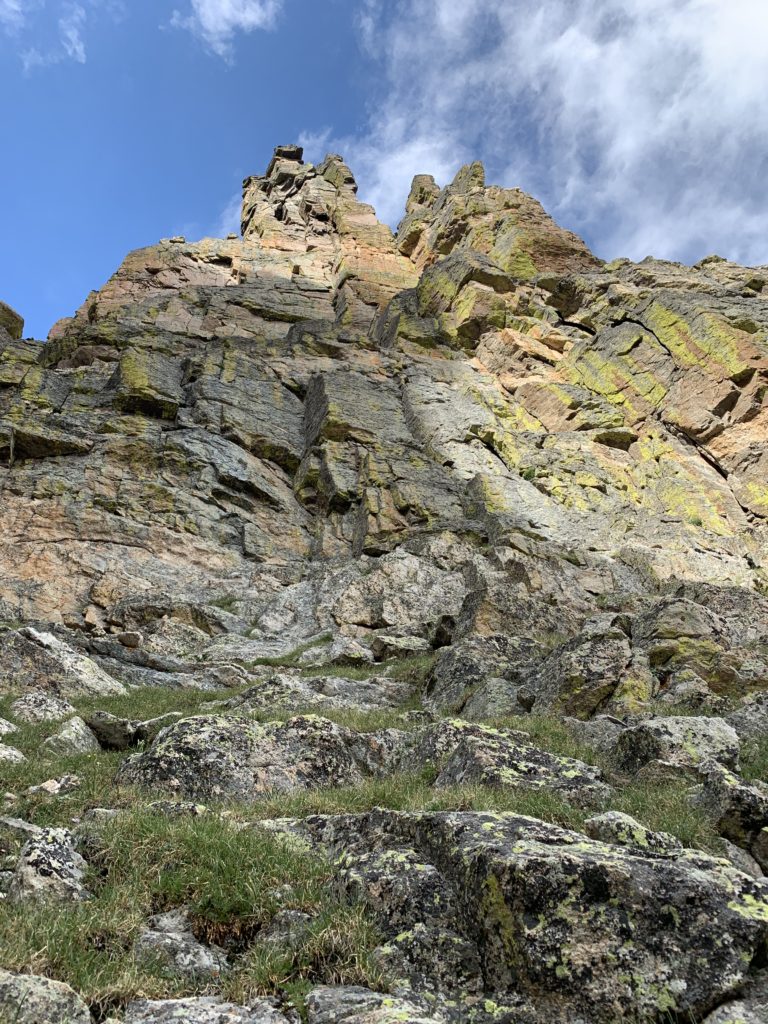
Clouds cleared and the sun came out halfway up. With the spire looming above, we were back in good spirits.
It was my lead. We were two pitches below the summit. The wall trended vertical again after some lower angle climbing. A tricky sequence off the belay ledge with hard-to-place gear cranked up the intensity meter. I executed and tried to calm down by reminding myself that every pitch was well within my abilities. The crux was the mental game. I worked my way up to a 15-foot, right-facing dihedral above another ledge. A #0.3 cam as high as I could reach from the ledge protected me as I finger-locked and laybacked my way up. At the top, I found a shallow alcove, but the headwall continued above and looked blank. To my left, on top of the corner, was another refrigerator-sized block. It was sitting on its short, bottom edge, tipped on its side towards the wall. There was a small triangle of space between it and the wall.
My first thought was there’s no way I’m climbing through that gap. That’s just asking to have it shift from its precarious position and either land on me, or slide off its ledge and tumble down the face. I managed to get a marginal #3 in the alcove to at least keep me off the deck while I worked out what I wanted to do. I shimmied along the horizontal edge of the alcove to an arete on my right. The climbing above looked okay, but gear would be sparse. I retreated back to my #3 and asked for a take.
I looked at the gap beneath the monster block again. I was pretty sure the route went left from where I was, but there was no way to get over there without going beneath or around the behemoth. I pulled back on and stuck my head and shoulders through the gap. My small pack bumped into the edge of the rock. Too big to fit. I sat back on the rope, side-eyeing the block to make sure my tap hadn’t thrown off its balance. With the gap clearly too small, I opted to try the arete again. I scooted back to the right and started climbing. Less than 5 feet onto the arete, I grabbed a nice chunk of rock, only to have the grapefruit-size piece pop off in my hand.
That was it. I flailed back to my last piece and hung on the rope. I focused on calming down and looking at what my options were. I knew I eventually needed to trend left, but with the death block in the way, I didn’t see a way to make it over there. I got lowered back to the little ledge at the start of the corner and looked around the side. The climbing looked relatively easy, and I’d be on the far side of the block. I grabbed my little #0.3 out of the corner, but left the #3 at the top. I climbed around the left side of the corner, up to the big block, and gingerly reached through the gap to retrieve the #3.
A couple more moves got me to a protected alcove, one pitch below the summit. Up until now, we’d been looking east and south down onto Rocky Mountain National Park and the Front Range. When I got to the ledge, I could now see around the wall, west over the rest of the mountains. And what I saw did not look good. Dark, angry clouds were practically on top of us. The frantic energy from earlier returned, and I hurriedly put my partner on belay and told him to book it. As he was breaking down the anchor below, I had half a thought to put on my rain shell. Not truly believing it would be necessary, I dug it out of my pack, put it on, and sat down in a comfortable spot.
Not a moment too soon. With a clap of thunder, the rain began. At first, I tried to keep my pack, myself, and the rope as dry as possible. After a few minutes, I knew it was futile, and surrendered to the rain and hail that pounded down as thunder clapped around us. Eli finally crawled over the lip into the alcove, and we hunkered down. As the rain let up, we started discussing options. There was a manky anchor that bailed out of the alcove to the south, made up of a rap ring and bunch of old tat tied around a suspect block. It required scrambling down out of the alcove, above big exposure, to be able to rig your rappel. We also weren’t confident we’d be able to get to the ground. The traditional descent from the summit involved 3 raps. Even if we could reach the ground directly below our location, we had no idea if we’d be able to rappel again to get back to where we started.
Our other option was to gain the summit, and follow the normal descent. The only potential issue with this plan was the weather. Sitting atop a tiny spire in a lightning storm didn’t seem like an ideal situation. Not to mention, we still had one more pitch to climb on wet rock to get to the top. We decided to hang out and see if the rain stopped and then make a decision. Incredibly, I had cell service and was able to fire off a text to my girlfriend. “We’re ok. Trying to figure out how to get down.” As we joked about how crazy this day had ended up turning out, the rain eventually quit, leaving us wet and a bit chilly, but once again in high spirits.
We decided that the worst of the weather seemed over, and we’d race to the top and rap as quickly as we could. Our beta indicated the rap stations were in excellent shape and would be straight forward. That seemed better than rapping off a sketchy anchor into unknown territory. My partner put our team on his back and lead the crux pitch of the route on slick rock after a mentally taxing day. He belayed me to the summit and we immediately started prepping our rappel. No summit selfies, no taking in the view. The clouds were still threatening and we were ready to get down.
I rapped down to a broad ledge, and before taking myself off rappel, confirmed I’d found the second rap station. While Eli followed, I had a chance to look around and snap some photos of the summit spire. When he reached the ledge, we pulled the rope and threaded it again. I worked my way slowly through a narrow, seeping gully. I touched down where the summit tower spire joins the main mountain, glad to have feet back on semi-solid ground. We swapped our rock shoes for our approach shoes. The descent beta said we would follow the wide gully between the tower and the mountain until the last rap put us back onto the scree field for the scramble back to the trail.
On our climb, right around the time we passed the bailing party, we had seen a shiny, two-bolt anchor on the east face of the wall. We had assumed this was the final rap anchor that would drop us neatly back where we had started. We were walking south, on the western side of the spire, but figured the gully would wrap around to the east face to access the final anchor. As we walked along, the gully came to an abrupt end. There was a forty-foot drop with a narrow ledge to our left that looked like it gained a shoulder on the south side of the spire and may lead around to the east face.
Stepping carefully, we traversed the ledge onto the shoulder. We walked around to the east, only to encounter another drop. There was no path back to the true east face. We were perplexed. How were we supposed to reach the final anchor? Had we missed a path that turned off the gully farther up? To add to the confusion, we found that someone had slung a huge boulder and bailed down the east-facing cliff. Again, we weren’t sure we’d be able to reach the ground, so we opted to scramble back across the ledge to make sure we hadn’t missed anything.
Another pass down the gully didn’t reveal anything new. Back on the shoulder, we discussed slinging a block and rapping down the western drop at its lowest point. On par with the rest of the rock quality, we didn’t find anything we’d be willing to trust with our lives. I was again getting rattled. The more we wandered around in these precarious places, the more likely we were to fall or get hurt. I hiked back up the gully a bit and sat down to re-evaluate.
We had to be missing something. I pulled Mountain Project up on my phone and read through the route beta again. It seemed straightforward. Two rappels, a short walk down the gully, then a third rappel. But no hint as to where the last rappel anchor was. As I waited for Eli to scramble back up to me, I scrolled through the user comments. In the more recent notes, I found what I was looking for. A climber had commented to stay descender’s right, against the mountain, until you come to the drop-off. Look about waist-high and you’ll find two bolts, painted to match the rock. Bingo.
We threaded the rope, flew to the ground, and breathed a big sigh of relief. If nothing else, we were on the ground. We practically sprinted down the scree field, back to the trail. The anxiety evaporated, all that was left to do was walk the four miles back to the car. It could rain, it could hail, we didn’t care. We knew we were going to make it. As the sun painted the sky behind the jagged peaks of the continental divide, we walked back into the parking lot.
It had been a long, tiring day, full of ups and downs, both literal and figurative. What I ultimately took away from the experience is how important it is to have a plan, remain calm when things go sideways, re-evaluate based on changing conditions, and have trust in your partner. I was able to keep my fear in check because Eli kept his in check. Freaking out was going to do nothing except cloud our judgment. Like all type 2 fun, as intimidating as it was, I can’t wait to go back and try it again. With any luck, we’ll pull it off in better style, and faster than fourteen hours!

